classic pesto
I grow a lot of basil. It’s an easy herb to grow, smells and tastes wonderful and is easy to maintain. I add it to so many summer dishes. You can grow basil in a pot or garden bed where it will get good sunlight and regular water. To keep your basil growing, remove the flowers when they appear, before they turn to seed. I leave the seeds on the soil in the pot and some will germinate again next year.
Pesto, traditionally made from basil, can be used as a dip, a spread, a sauce stirred through pasta or stirred into soups or casseroles. Using only basil leaves, extra virgin olive oil, pine nuts, garlic and a strong cheese, this is a quick and delicious spread. I use a sheeps’ pecorino from the Italian deli for its strong and delicious flavour. Also, too much cows’ milk doesn’t really sit well with me.
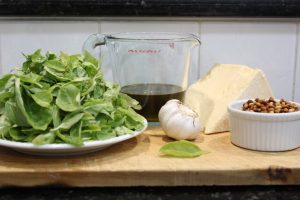

Gather the ingredients and a blender. Purists insist on pounding the ingredients by hand in a mortar and pestle but I can’t taste the difference between pounded or blended pesto. You choose! Make sure you have a clean, sterilised jar and lid ready for bottling the pesto. I use recycled jam jars. The ingredients I’ve listed make about one jam jar of pesto and sufficient to stir through pasta that night.
Ingredients;
50 gm of fresh pine nuts
80 gm basil leaves, no stems
50 gm of parmesan or other strong cheese of your choice, grated roughly
2 garlic cloves or 2 teaspoons of minced garlic
75 ml extra virgin olive oil
Rinse the basil leaves and pat dry. Then heat a small frying pan over low heat and gently toss the pine nuts in a little extra oil until they are golden. Be careful not to let them burn as they will taste bitter.You can substitute almonds, pistachios or walnuts if you don’t have pine nuts
Tip the pine nuts, basil leaves, garlic and grated cheese into the blender and blitz until they are roughly chopped. Run the motor and slowly pour in the oil. When it is well mixed but still has shape use a spatula to transfer the pesto into a jar. I used a 370gm recycled jam jars with a tight fitting lids. The pesto will keep for about 10 days in the fridge, if you can leave it alone for that long!
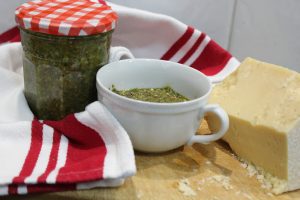

The traditional recipe for pesto uses basil, but there’s many variations depending on what is growing in your garden or what herbs you have on hand to use up. You can add mint or parsley, too. Wonderful stirred through pasta or gnocchi, under a poached egg on toast, on a pizza, stirred into soup or drizzled on a tomato salad.
foreign money
Once we used to go to the bank and organise some foreign currency to take overseas. Then that changed and we have to go into the city to specific branches of the bank to get money. We’d have to order it then wait a few days before we could make the trek into the city and collect the money. Now there is only one branch where we could collect foreign currency.


Searched online for an easier alternative and found one, an online currency exchanger. We ordered the currency and denominations we wanted and made a bank transfer to pay. Two days later the money arrived at our local post office. It was in a plastic pouch in a cardboard box. This entire transaction cost us AU$14, a better exchange rate compared to the bank. It was very easy to complete.


The money was the denominations we selected wrapped with a receipt showing the value and the number of each bank note. It took minutes to order and was easy to pick up later. So much easier than dealing with the bank. When you try and organise this with the bank they would prefer to supply a foreign currency credit card which is very profitable for them. Their deal also includes a charge incorporated in the exchange rate to pay for their time.
food waste
I don’t like wasting food! I see frightening figures quoting the amount of food first World countries send to landfill. Sometimes it takes a lot of work and planning to use everything we’ve bought. Bread is a big problem in this house. I make sourdough for myself and eat it all. Two days before the whole loaf is gone I feed the starter and 12 hours later I mix the dough and leave it for another twelve hours. Then I bake it. It’s a routine I’m used to and not difficult. Besides, the bread is wonderful!
My husband like artisan loaves he buys from two preferred bakeries. He never finishes a loaf. I can make bread and butter puddings but not in the middle of summer. I can make panzanella salads. But mostly I make breadcrumbs. I simply cut the remnant bread to fit easily in the processer and blitz the chunks until they are fine bread crumbs. I use them mostly to make meatballs, chicken balls and sometimes coated chicken. No waste.
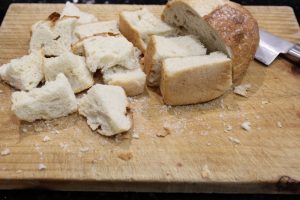

Chop into small pieces.
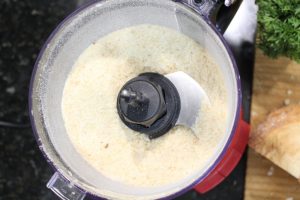

Blitz.
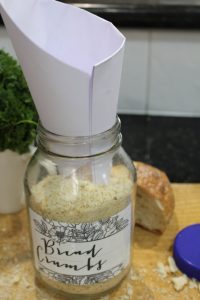

Using a high tech funnel store the breadcrumbs in a jar.
